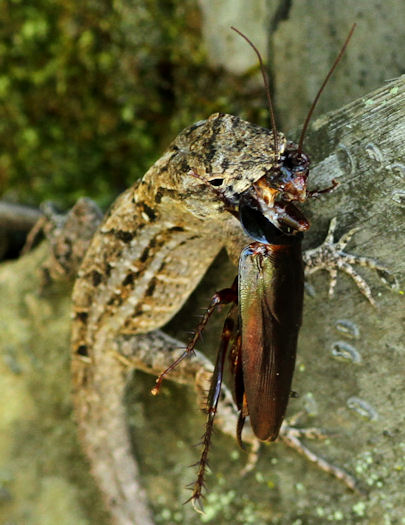httpv://youtu.be/Du9oQr8PQC4
This occurred at 10:20 AM April 12, 2004 in South Miami Florida. I was working in my kitchen at my home in South Miami Florida with my back porch door open, when my attention was captured by a loud “yelp-yelp” sound in repetition. I also noticed that I heard the “distress” call of a cardinal – similar to what I would hear if there was a cat or snake in my backyard. I grabbed my Sony cybershot 3.2MP and ran out my back door. On an adjacent pony tail palm (Nolina recurvate) just below the crown, about 8’ off the ground I saw a large knight anole (Anolis equestris) in a head down position. The anole had in its mouth, the back legs (below the knees) of a Cuban treefrog (Osteopilus sepentrionalis). The frog was making a very loud repetitive “yelp-yelp” sound while trying to climb out/away from the lizard’s mouth using its front legs. There were a pair of cardinals and mockingbirds, and a blue jay that were attracted to the sound. The cardinal was calling, and the mockingbird was approaching and slowly opening and moving its wings in a “swimming fashion,” making it obvious as it walked across the ground. The birds’ focus seemed due to the frog’s call. I have never experienced any reaction of a bird to the many resident Knight anoles in my property or elsewhere. I managed to get a short clip (meaning to take an image) and a captured still is what you see attached. After a few more cycles of yelping, the frog managed to break free from the Anolis’ mouth and hopped away behind my AC unit. Having had some firsthand past experience with Osteopilus’s antipredatory compounds, I wondered if they had the same effect on lizard’s bucccal cavity as they did on this (at the time intoxicated) human. I had heard a very similar call from an unidentified tree frog in Costa Rica 1998. It had been captured by a parrot snake (Leptophis sp.) that fell to the ground in front of a friends horse while we were jungle riding in Guanacaste. To humans, the call does sound very much like a baby, or toddler’s wail. I would be interested in knowing if it serves to attract other predators giving the “crier” a possible distracting means of escape.



 This, in turn, reminds us of
This, in turn, reminds us of  Periodically, we’ve discussed how green and brown anoles interact now that they’ve been thrown into sympatry in the southeastern U.S. and elsewhere–do they
Periodically, we’ve discussed how green and brown anoles interact now that they’ve been thrown into sympatry in the southeastern U.S. and elsewhere–do they 















